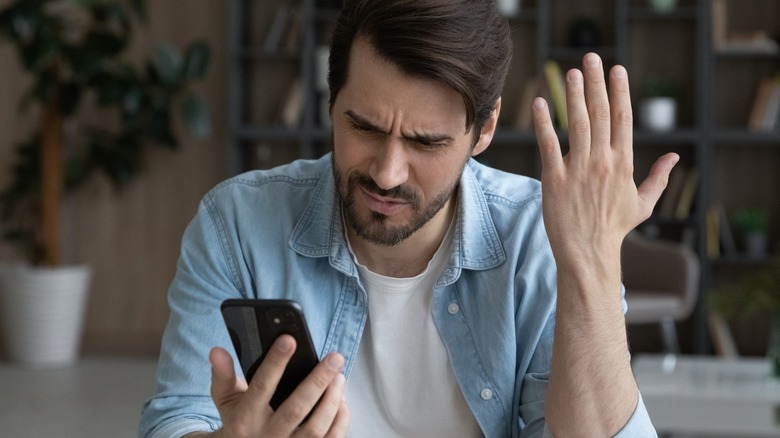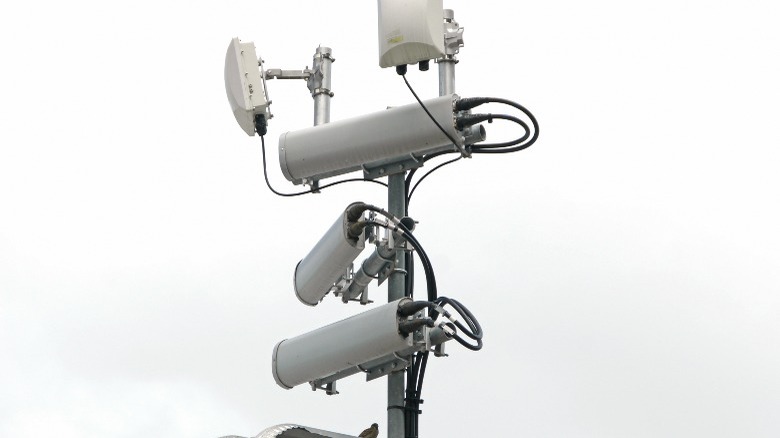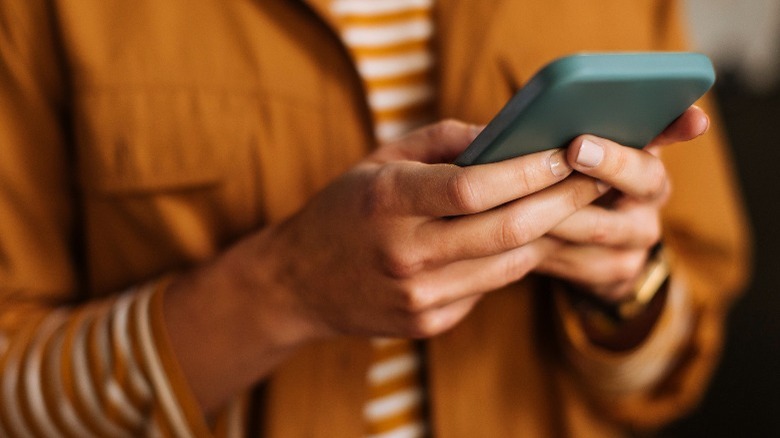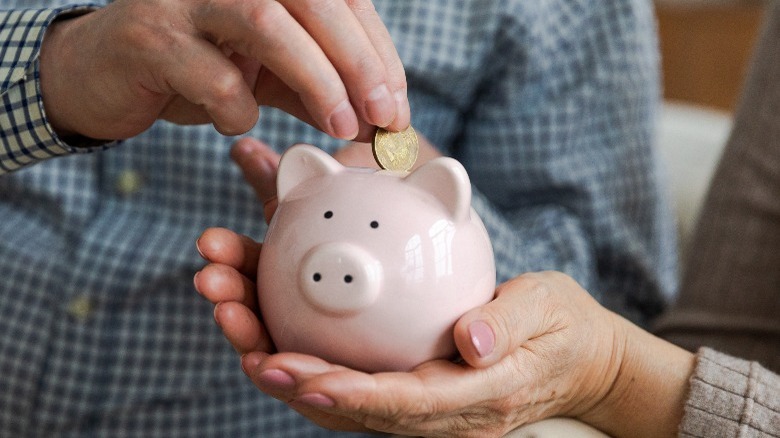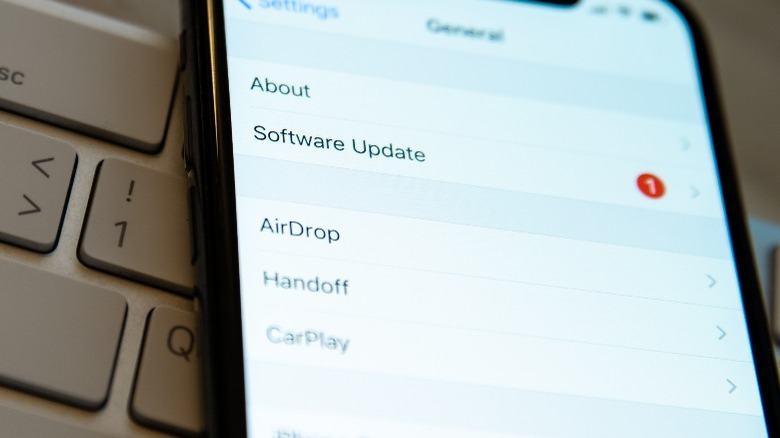Will A Signal Booster Really Work On Your iPhone? Here's What You Need To Know
We may receive a commission on purchases made from links.
Whether you live in a rural area or plan to hit the road but need to continue working remotely, there's nothing worse than seeing no bars on your iPhone. Not being able to stay connected with the outside world, make uninterrupted calls, and browse the internet is definitely a concern for most nowadays. Unfortunately, there's not much you can do in such situations besides desperately waiting to see a signal bar.
If you've tried every troubleshooting fix available on the web including re-inserting your sim and contacting your carrier, a signal booster may be your last available option. Although signal booster cell phone apps are a scam, investing in a physical signal booster when you're stuck in such a situation can improve your device's signal strength.
However, a signal booster's success is contingent on various factors and they might not end up working as well as advertised on your iPhone.
What is a signal booster?
A signal booster, commonly known as a signal amplifier or cell phone repeater, is an electronic device designed to improve your phone's connection to your wireless carrier's network. These devices increase the strength of LTE, 5G, and 4G cellular signals indoors.
Signal boosters consist of three main components: an external antenna, an internal antenna, and an amplifier. As the name suggests, the external antenna needs to be placed outside your home in a location where it can receive maximum signal. The higher you place the external antenna, the better signal you receive.
On the other hand, the internal antenna needs to be placed in the area you want to improve the signal. For instance, if you're purchasing a signal booster to improve cell phone reception in a single room, placing the internal antenna in the middle of your ceiling might be a good idea. The most essential component of the device, the amplifier, is responsible for receiving the signal from the external antenna, amplifying the weak signal, and sending it to the internal antenna which then rebroadcasts the enhanced signal.
While signal boosters are legal within the United States, they must be FCC-certified and you must register it with your carrier once you purchase it. Although these electronic devices can do a great job amplifying weak signals, they may not be the most optimal choice for your specific use case.
A signal booster won't work if there's no signal at all
Signal boosters are designed to amplify existing weak signals, not create them out of thin air. Ultimately, they're only effective if the signal outside your home or workspace is optimal. While you can use the signal bars to gauge whether you have a weak or strong signal, they're unfortunately not a reliable indicator of your true signal strength. Sometimes, the signal is so weak that your device struggles to pick it up.
Instead, if you want an accurate reading of the amount of signal strength your device currently has you can use the Field Test Mode on your iPhone. Note that the menu might differ based on your region or carrier, but the steps below should guide you in finding what you're looking for. To do so, open your iPhone's Phone app and dial *3001#12345#*. On the next screen, tap RsrpRsrqSinr under the LTE header. The figure that you see next to RSRP (Reference Signals Received Power) indicates your device's signal strength, which is measured in decibel milliwatts (dBm). The RSRP figure is a negative number, and the closer it is to zero, the stronger the signal.
If your signal strength is close to or lower than – 100 dBm, it indicates that your device has an extremely weak signal. Similarly, -110 dBm indicates no signal as well. According to weBoost, if your signal strength is lower than – 100 dBm, it is likely that a signal booster will be unable to help improve your signal. However, a signal strength of -85 or stronger is usually a good indicator, and a signal booster can help your case.
A signal booster might not be worth it if you're on a budget
A signal booster's price varies depending on a multitude of factors including the area you wish to cover, the brand you plan on purchasing, and the signal strength you're looking for. The price also changes drastically depending on whether you'd like to get a signal booster for your home or a vehicle.
For instance, the weBoost Home MultiRoom covers "three large rooms", and is priced at $569.99. However, boosters designed for larger spaces, such as homes or offices, often come with a higher price tag compared to those intended for smaller areas like vehicles.
The SureCall Fusion4Home Phone Signal Booster is a comparatively affordable option, priced at $499.99, and is designed for home and office use. Similarly, the weBoost Drive Sleek is an in-vehicle cell signal booster, designed for single users and is priced at $199.99. While all three of the boosters mentioned above enhance both 5G and 4G LTE signals, the cost of the device you choose may increase based on whether you prefer a device that boosts 5G signals as well.
The extent to which you need to amplify your signal also affects the price of the booster. Boosters designed for areas with weak signals or remote locations might be more expensive due to their advanced capabilities. The price also increases if you plan to get it installed by a professional.
A signal booster won't fix your device's software issues
Unfortunately, even if you purchase one of the best cell phone boosters, they'll be unable to fix software issues in your iPhone. Therefore, it is a good idea to eliminate the possibility of any software issues causing your device to lose its signal by performing some basic troubleshooting steps before investing in a signal booster.
To begin, go to your iPhone's settings and tap on the toggle next to Airplane Mode. Doing so will temporarily disconnect your iPhone from existing Wi-Fi connections, disable Bluetooth, and restart the cellular network modems. Wait a few seconds and tap on the toggle again. Now, your iPhone will attempt to find the best signal within your area.
Restarting your iPhone is often the best way to fix minor software glitches. If the issue persists, try shutting down your iPhone and turning it back on after waiting a few seconds. Resetting your device's network settings is always a good option and is often guaranteed to work when it comes to connectivity issues.
Once you reset your iPhone's network settings, all your network settings will return to their default state, and all network-related data on your device will be erased permanently. Here's how to reset your iPhone's network settings:
-
Go to Settings and tap General.
-
Tap Transfer or Reset iPhone.
-
Tap Reset.
-
Choose Reset Network Settings.
A signal booster won't work outdoors
While many think signal boosters are only designed for use inside homes and offices, you can also use them to improve cell phone reception in cars, trucks, SUVs, and RVs if you travel often. However, signal boosters aren't designed to be used outdoors.
Signal boosters are designed to work in confined spaces. Once the signal booster amplifies the weak signals and the internal antenna broadcasts it into the desired place, the device relies on the confined space for consistent coverage. For instance, if you're using a signal booster to improve your cellular connection at home, the amplified signals will bounce off your walls. Similarly, if you're using the device in your RV, the amplified signals will bounce off your vehicle's interior.
Outdoor environments are also subject to various external interferences, including weather conditions, atmospheric disturbances, and competing signals from neighboring areas. If you place a signal booster in an outdoor setting, the signal will eventually dissipate and fade into nothing as the absence of walls or structures does not allow signals to reflect properly. In an open environment, the signal travels freely but faces natural obstacles like trees, hills, and buildings, leading to signal degradation over distance.
